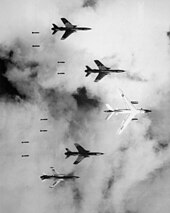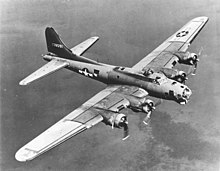High level bombing

High level bombing(also calledhigh-altitude bombing) is a tactic of droppingbombsfrombomberaircraftinlevel flightat high altitude. The term is used in contrast to bothWorld War II-eradive bombing[2]and medium or low level bombing.
Prior to the modern age ofprecision-guided munitions(PGMs), high level bombing was primarily used forstrategic bombing—inflicting mass damage on theenemy's economy and population—not for attacks on specific military targets. High level bombing missions have been flown by many different types of aircraft, includingmedium bombers,heavy bombers,strategic bombersandfighter-bombers.
The choice to use high level bombing as an offensive tactic ofaerial warfareis dependent not only upon the inherent accuracy and effectiveness of the bombing aircraft and their deliveredordnanceon the target, but also upon a target'sair defensecapabilities. From the 1940s onward,radarin particular became a powerful new defensiveearly warningtool, and a serious threat to attacking aircraft when they flew at higher altitudes towards their target.
Bombing from medium to high altitudes, especially in the post-World War II era with sophisticatedsurface-to-air missiles,interceptor aircraftandradarsexposes attacking bomber aircraft to greater risks of detection, interception and destruction. DuringWorld War II,various methods were employed to protect high level bombers fromflak,fighter aircraftand radar detection, including defensivearmament,escort fighters,chaffandelectronic jamming.Modernstealth aircrafttechnologies, for example, can alleviate some risks inherent to high level bombing missions, but are not a guarantee of success or permanent solution for the attackers.
World War II
[edit]
High level bombers were primarily used by theAlliesforcarpet bombing(particularly later in the war), such as thebombing of DresdenorTokyo.They were also deployed in other kinds of missions such asOperation Tidal Wave,Operation Crossbow,and thesinking of the Tirpitz.
After initial operations by day suffered heavy losses, the British switched to night-timesortieswhere the darkness gave some protection against German fighters.Arthur "Bomber" Harris's strategy for theRAF Bomber Commandwas to attack area targets that the bombers could be more certain of hitting at night, while theU.S.preferred daylight,precision bombingtechniques.[3]The development since the 1930s ofgyroscope-stabilised opticalbombsights,such as theNorden bombsight,also helped the Allied air forces' ability to accurately strike their targets with medium- to high-altitude level bombing attacks.
Nazi Germanyused high level bombers such as theHeinkel He 111,theDornier Do 17and multi-role aircraft such as theJunkers Ju 88against the Allies in theBattle of Britain,[4]both for carpet bombing and for precision attacks on Britishradarstations as part ofOperation Eagle.[5]
Cold War
[edit]
During theCold War,theUnited StatesandSoviet Unionused several bomber designs,[6]but the bulk of their offensive forces were in the form of, respectively, theB-52 StratofortressandTu-95 Bear.TheFrenchequivalent was theMirage IV,and theUKhad itsV bombers.
The U.S.Strategic Air Command(SAC) ordered massive high level bombing inOperation Rolling ThunderandOperation Menu[7]during theVietnam War.[8]
See also
[edit]- Attack aircraft
- Fighter-bomber
- Heavy bomber
- Light bomber
- Medium bomber
- Schnellbomber
- Strategic bombing
References
[edit]- ^Jacob Van Staaveren, "Gradual Failure: The Air War over North Vietnam: 1965–1966" (Washington, D.C.: Air Force History and Museums Program, 2002), p 226–227.
- ^"The Bomber War" by Robin Neillands,ISBN0-7195-5637-6,p.35
- ^"The Bomber War" by Robin Neillands,ISBN0-7195-5637-6,p.23
- ^"The Bomber War" by Robin Neillands,ISBN0-7195-5637-6,Chapter 2
- ^"History of the Second World War, ed. Sir Basil Liddell Hart,ISBN0-907305-36-9,p.74
- ^White, W.L. (2007).Report on the Russians.Read Books. p. 39.ISBN9781406749304.Retrieved2015-03-02.
- ^"The Walrus » Bombing Cambodia » Bombs over Cambodia » History".Archived fromthe originalon 2010-01-14.Retrieved2010-05-09.
- ^"Bombing of Cambodia - Ohio History Central".ohiohistorycentral.org.
